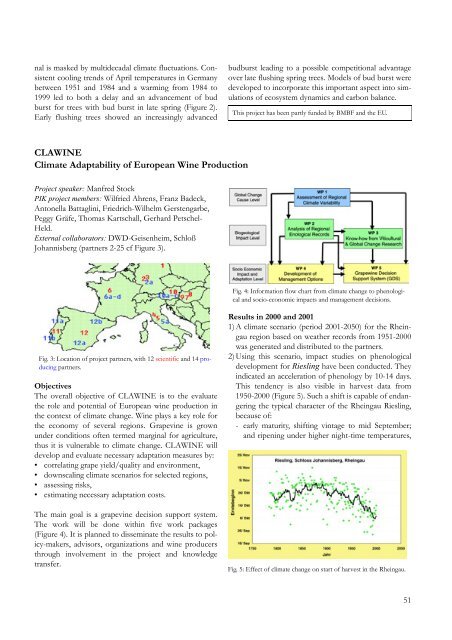PIK Biennial Report 2000-2001 - Potsdam Institute for Climate ...
PIK Biennial Report 2000-2001 - Potsdam Institute for Climate ...
PIK Biennial Report 2000-2001 - Potsdam Institute for Climate ...
You also want an ePaper? Increase the reach of your titles
YUMPU automatically turns print PDFs into web optimized ePapers that Google loves.
nal is masked by multidecadal climate fluctuations. Consistent<br />
cooling trends of April temperatures in Germany<br />
between 1951 and 1984 and a warming from 1984 to<br />
1999 led to both a delay and an advancement of bud<br />
burst <strong>for</strong> trees with bud burst in late spring (Figure 2).<br />
Early flushing trees showed an increasingly advanced<br />
CLAWINE<br />
<strong>Climate</strong> Adaptability of European Wine Production<br />
Project speaker: Manfred Stock<br />
<strong>PIK</strong> project members: Wilfried Ahrens, Franz Badeck,<br />
Antonella Battaglini, Friedrich-Wilhelm Gerstengarbe,<br />
Peggy Gräfe, Thomas Kartschall, Gerhard Petschel-<br />
Held.<br />
External collaborators: DWD-Geisenheim, Schloß<br />
Johannisberg (partners 2-25 cf Figure 3).<br />
Fig. 3: Location of project partners, with 12 scientific and 14 producing<br />
partners.<br />
Objectives<br />
The overall objective of CLAWINE is to the evaluate<br />
the role and potential of European wine production in<br />
the context of climate change. Wine plays a key role <strong>for</strong><br />
the economy of several regions. Grapevine is grown<br />
under conditions often termed marginal <strong>for</strong> agriculture,<br />
thus it is vulnerable to climate change. CLAWINE will<br />
develop and evaluate necessary adaptation measures by:<br />
• correlating grape yield/quality and environment,<br />
• downscaling climate scenarios <strong>for</strong> selected regions,<br />
• assessing risks,<br />
• estimating necessary adaptation costs.<br />
The main goal is a grapevine decision support system.<br />
The work will be done within five work packages<br />
(Figure 4). It is planned to disseminate the results to policy-makers,<br />
advisors, organizations and wine producers<br />
through involvement in the project and knowledge<br />
transfer.<br />
budburst leading to a possible competitional advantage<br />
over late flushing spring trees. Models of bud burst were<br />
developed to incorporate this important aspect into simulations<br />
of ecosystem dynamics and carbon balance.<br />
This project has been partly funded by BMBF and the EU.<br />
Fig. 4: In<strong>for</strong>mation flow chart from climate change to phenological<br />
and socio-economic impacts and management decisions.<br />
Results in <strong>2000</strong> and <strong>2001</strong><br />
1) A climate scenario (period <strong>2001</strong>-2050) <strong>for</strong> the Rheingau<br />
region based on weather records from 1951-<strong>2000</strong><br />
was generated and distributed to the partners.<br />
2) Using this scenario, impact studies on phenological<br />
development <strong>for</strong> Riesling have been conducted. They<br />
indicated an acceleration of phenology by 10-14 days.<br />
This tendency is also visible in harvest data from<br />
1950-<strong>2000</strong> (Figure 5). Such a shift is capable of endangering<br />
the typical character of the Rheingau Riesling,<br />
because of:<br />
- early maturity, shifting vintage to mid September;<br />
and ripening under higher night-time temperatures,<br />
Fig. 5: Effect of climate change on start of harvest in the Rheingau.<br />
51

















